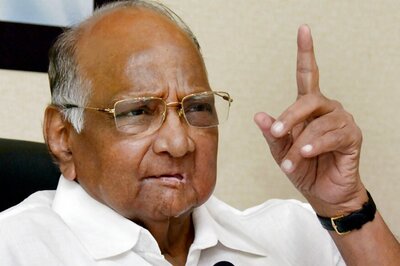
views
“Long years ago we made a tryst with destiny, and now the time comes when we shall redeem our pledge, not wholly or in full measure, but very substantially. At the stroke of the midnight hour, when the world sleeps, India will awake to life and freedom.”
With these words by Pandit Jawaharlal Nehru from the Red Fort on the midnight of August 14, 1947, a new country with 14.9% population on 2.4% of Earth’s land was born. And along came concerns of providing good education, healthcare, adequate food and employment to the people of this new nation.
Soon after Independence, the Indian government understood that it would be difficult in the future to provide resources for such a large population. The first Census was conducted in the year 1951 and it was found that the total population of India was about 360 million. Keeping this in mind, India started the world’s first official family planning program in 1952.
Despite the publicity of family planning programmes, concerns grew with India’s rising population from 360 million to around 440 million in the 1961 Census. Keeping this in mind, the country’s first comprehensive condom distribution program was launched by the Government of India in 1963. That condom was named ‘Kamaraj’, but since it sounded like the name of the then Congress party president K Kamraj, it was later renamed as ‘Nirod’. In 1966, a PSU named Hindustan Latex Limited (HLL) was established to provide contraceptive facilities for family planning to the citizens of India.
Despite all this, the population of the country increased from 440 million to around 550 million in the 1971 Census. Till then, family planning was not a part of our Constitution. Keeping this in mind, through the 42nd amendment of the Constitution in the year 1976, population control and family planning were added to the Concurrent List mentioned in the Seventh Schedule of the Constitution by point number 20A, which came into effect from January 1, 1977. Target-based sterilisation programs were conducted for population control. It is said that around 6.2 million people were sterilised in India during that period. Despite all these efforts, the population of the country increased from 550 million to around 680 million in the 1981 Census.
Keeping an eye on population-control programs in India in the 1970s, China also started making efforts towards population control. In 1979, China came up with the One Child Policy for the next 35 years with the goal of preventing 400 million new births and that goal was achieved by China in 38 years. After that, to maintain the replacement level, birth of two or three children in many areas was allowed by China, which the so-called intellectuals call the failure of China’s One Child Policy.
In 1979, India’s per capita income and economy was almost equal to that of China, while China is more than three times bigger than India in terms of area and resources. This means that the Indian economy was three times better than that of China at that time and there is no need to tell where China’s economy is today compared to India after population control.
Looking at the 1981 population figures, then Rajya Sabha MP NP Chengalraya introduced India’s first private member bill on population control in Parliament on April 29, 1983. Since then, 43 MPs from different political parties have introduced private bills in Parliament for population control, but only one bill presented by MP Rakesh Sinha came into discussion, which was withdrawn by him before discussion.
According to the National Health Policy 1983, it was stated that at the current rate of decline in the total fertility rate, India would achieve the replacement level i.e. 2.1 TFR in the year 2000. Whereas according to the current NHFS-5 survey, that rate has been achieved in 2022. This proves that our population has not decreased as fast as it should have.
According to the 1991 Census, the population of India increased from 680 million to around 850 million even after concerns over India’s growing population were voiced in Parliament.
Two important decisions were taken by the then PV Narasimha Rao government with the intention that public representatives and government officials became a role model for the society, seeing that other countrymen could also be inspired to give birth to fewer children. First, in 1992, the 79th Constitutional Amendment Bill was introduced in Parliament by then health minister ML Fotedar on behalf of the government in the Rajya Sabha, on the basis of which the MLAs and MPs were to be brought under the two-child norm.
If that Bill were passed in Parliament, no person with more than two children could become an MLA or MP, but due to the opposition of many MPs and political parties, the bill brought by the government could not be discussed.
Second, in 1993, Section 17 of the All India Service Conduct Rules 1968 was amended to add section 17A, according to which, the two-child norm has to be followed mandatorily by all officers of the Indian Administrative Service, Indian Police Service and Indian Forest Service. But this rule has not been followed till date.
In 1994, India signed the Cairo convention document of International Conference for Population and Development (ICPD) without stating its side, after which the new population policy was implemented in India in 2000.
Aastha Arora, a girl born on May 11, 2000 at Delhi’s Safdarjung Hospital, has been declared the billionth child of the country by the Government of India. After that, according to the 2001 Census, the population of India increased from 850 million to 1.02 billion. Despite following the new population policy since 2000, the population of India increased from 1.02 billion to 1.21 billion, according to the 2011 Census.
On December 2018, Responsible Parenthood Act drafted by me was introduced in Parliament as a private bill for the purpose of population control, by Dr Sanjeev Balyan with the support of 125 MPs. Prime Minister Narendra Modi addressed the nation about the population explosion from the Red Fort on August 15, 2019. It is a gesture of great concern for the future.
Census 2021 could not be done on time due to the Covid-19 situation, because of which the actual current figures are not available. But according to a recent UN report, India will surpass China in 2023 to become the world’s most populous country. This means that at present, India’s population at least 1.4 billion.
So a country which was the first to act on population control could become the most populous country in the world and yet some so-called intellectuals constantly argue against making proper policy for population control. As India celebrates Azaadi Ka Amrit Mahotsav to mark 75 years of Independence, a question comes to mind – when will India gain freedom from the growing population?
The author is a population expert and president of the Taxpayers Association of Bharat. Views expressed are personal.
Read the Latest News and Breaking News here




















Comments
0 comment